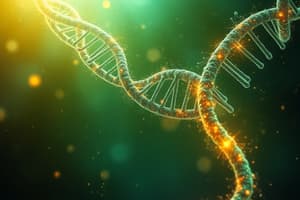Podcast
Questions and Answers
Match the following terms with their definitions:
Match the following terms with their definitions:
Transcription = Process of transcribing genetic information from DNA to RNA Translation = Process of producing proteins using the RNA transcript Antisense strand = Template strand for RNA polymerase during transcription Sense strand = Strand of DNA that is not transcribed during transcription
Match the following nucleotide pairs with their correct base pairing:
Match the following nucleotide pairs with their correct base pairing:
Guanine-Cytosine (G-C) = Nucleotide base pairing during RNA transcription Adenine-Uracil (A-U) = Nucleotide base pairing in RNA instead of A-T in DNA Thymine-Adenine (T-A) = Base pairing in DNA instead of A-U in RNA Cytosine-Guanine (C-G) = Complementary base pairing with Guanine in DNA
Match the following components with their roles in transcription:
Match the following components with their roles in transcription:
RNA polymerase = Enzyme responsible for transcribing DNA to RNA Promoter region = Specific area on DNA where RNA polymerase attaches Transcription factors = Enzymes that unwind DNA for RNA polymerase to transcribe Terminator sequence = Sequence on DNA where transcription ends
Match the following terms with their functions in gene expression:
Match the following terms with their functions in gene expression:
Match the following processes with their descriptions:
Match the following processes with their descriptions:
Match the following nucleic acids with their composition:
Match the following nucleic acids with their composition:
Match the RNA polymerase with their respective genes they transcribe:
Match the RNA polymerase with their respective genes they transcribe:
Match the components involved in translation with their functions:
Match the components involved in translation with their functions:
Match the ribosome subunits with their functions:
Match the ribosome subunits with their functions:
Match the terminus of a polypeptide chain with their chemical group:
Match the terminus of a polypeptide chain with their chemical group:
Match the stop codon with their function during translation:
Match the stop codon with their function during translation:
Match the post-translational modification with its purpose:
Match the post-translational modification with its purpose:
Flashcards are hidden until you start studying




